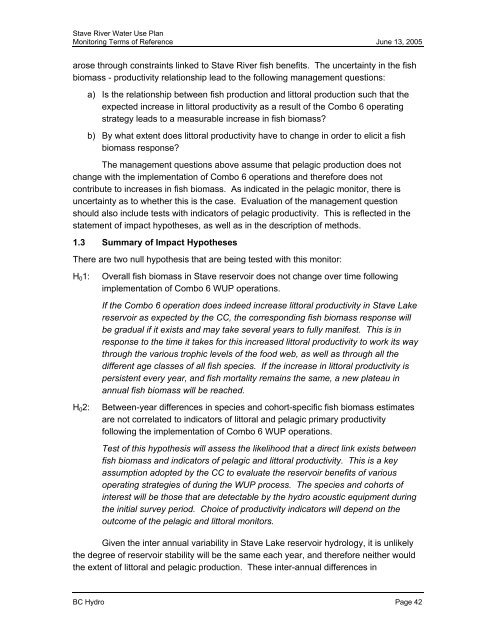Stave River Water Use Plan - BC Hydro
Stave River Water Use Plan - BC Hydro
Stave River Water Use Plan - BC Hydro
You also want an ePaper? Increase the reach of your titles
YUMPU automatically turns print PDFs into web optimized ePapers that Google loves.
<strong>Stave</strong> <strong>River</strong> <strong>Water</strong> <strong>Use</strong> <strong>Plan</strong><br />
Monitoring Terms of Reference June 13, 2005<br />
arose through constraints linked to <strong>Stave</strong> <strong>River</strong> fish benefits. The uncertainty in the fish<br />
biomass - productivity relationship lead to the following management questions:<br />
a) Is the relationship between fish production and littoral production such that the<br />
expected increase in littoral productivity as a result of the Combo 6 operating<br />
strategy leads to a measurable increase in fish biomass?<br />
b) By what extent does littoral productivity have to change in order to elicit a fish<br />
biomass response?<br />
The management questions above assume that pelagic production does not<br />
change with the implementation of Combo 6 operations and therefore does not<br />
contribute to increases in fish biomass. As indicated in the pelagic monitor, there is<br />
uncertainty as to whether this is the case. Evaluation of the management question<br />
should also include tests with indicators of pelagic productivity. This is reflected in the<br />
statement of impact hypotheses, as well as in the description of methods.<br />
1.3 Summary of Impact Hypotheses<br />
There are two null hypothesis that are being tested with this monitor:<br />
H01: Overall fish biomass in <strong>Stave</strong> reservoir does not change over time following<br />
implementation of Combo 6 WUP operations.<br />
If the Combo 6 operation does indeed increase littoral productivity in <strong>Stave</strong> Lake<br />
reservoir as expected by the CC, the corresponding fish biomass response will<br />
be gradual if it exists and may take several years to fully manifest. This is in<br />
response to the time it takes for this increased littoral productivity to work its way<br />
through the various trophic levels of the food web, as well as through all the<br />
different age classes of all fish species. If the increase in littoral productivity is<br />
persistent every year, and fish mortality remains the same, a new plateau in<br />
annual fish biomass will be reached.<br />
H02: Between-year differences in species and cohort-specific fish biomass estimates<br />
are not correlated to indicators of littoral and pelagic primary productivity<br />
following the implementation of Combo 6 WUP operations.<br />
Test of this hypothesis will assess the likelihood that a direct link exists between<br />
fish biomass and indicators of pelagic and littoral productivity. This is a key<br />
assumption adopted by the CC to evaluate the reservoir benefits of various<br />
operating strategies of during the WUP process. The species and cohorts of<br />
interest will be those that are detectable by the hydro acoustic equipment during<br />
the initial survey period. Choice of productivity indicators will depend on the<br />
outcome of the pelagic and littoral monitors.<br />
Given the inter annual variability in <strong>Stave</strong> Lake reservoir hydrology, it is unlikely<br />
the degree of reservoir stability will be the same each year, and therefore neither would<br />
the extent of littoral and pelagic production. These inter-annual differences in<br />
<strong>BC</strong> <strong>Hydro</strong> Page 42
















